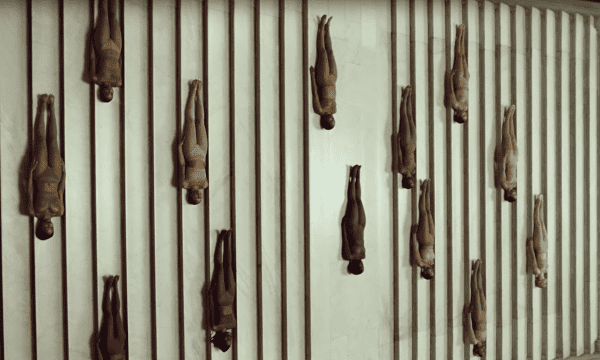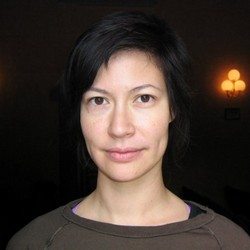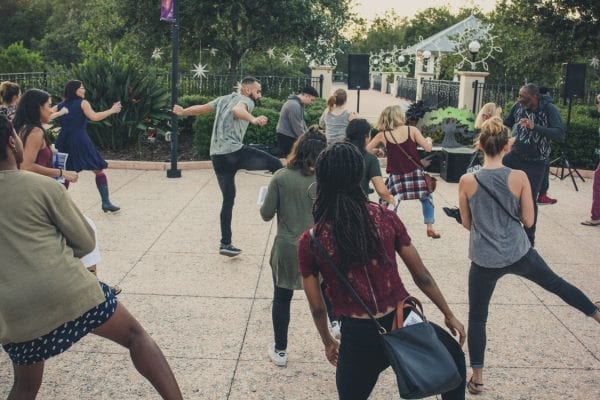
Demystifying the Art of Dance
Dance has been crossing boundaries of genre, location, and socioeconomics, and has come into its own as a vital form of everyday expression.
BY JULIE GARISTO | Oct. 29, 2018
Those of us who didn’t study dance may feel like we’re on one side of the us-and-them dance divide, but that perceptual boundary has blurred more and more through the years.
Breakthroughs in contemporary dance have encouraged a deeper appreciation and accessibility. There are now a wide array of approaches and techniques, more ways to tell a story through dance that’s more visceral — and most importantly, inclusive of different body shapes, ages and abilities.
Says St. Petersburg dancer Andee Scott: “Our bodies hold our connection to truth. Phrases like ‘Gut feeling’; ‘I know it in my bones’; ‘Knot in my stomach’; — these sayings come from somewhere — I believe that as a physical, embodied art form, dance has the potential to connect people to their own humanity through an awareness of the body. Mirror neurons facilitate kinesthetic empathy; when we watch dance, our bodies connect with a sense of motion, and this awareness activates our experience of our own bodies. ” (More from Ms. Scott later.)
Pop Goes an Art Form
Pop music has brought envelope-pushing, expressive dance to the masses. Since the 1980s, dominated by Madonna’s sundry gesticulations and the zombie chorus line of Michael Jackson’s “Thriller” — revived once again this Halloween season — dancers and choreographers have upped the ante on artistic delivery.

In the past decade, “Chandelier” by Sia — performed live and in videos by young dancer Maddie Ziegler — created quite a buzz and led to an onslaught of parodies. Almost but not quite lost in the hype was the artist’s ideas on the pendulous emotions of mania and addiction. In this instance, teen fans learned about how a dancer can tell a story without buying a ticket to a performance.
And Let’s not forget Kanye West. Though he offends millions with his ill-conceived provocations, Yeezy has been a pioneer of artfully provocative in music videos. His 2010 extended video film “Runaway” upped the ante with a mixture of classical ballet and modern dance, conceived by Czech choreographer Yemi Akinyemi Dele.

This year, choreographer Sherrie Silver helped Childish Gambino turn heads with a mixture of hip-hop, South African folk dance and pointed political narrative in the video for “This is America.” Other recent stunners include the evocative performances of The Carters’ “Apeshit” and the sleek gesticulations of The xx’s “Islands.”
It’s been encouraging for appreciators of the form to see how dance has emerged from the background in pop music. Teens (and fans all ages) across America are learning artful moves on Youtube, and cutting-edge dance has become more diverse and expressive, challenging our expectations of physicality and movement in art.
From pop to pop-ups
Locally, pop-up performances have provided more immediate and accessible avenues to appreciate contemporary dance and continue to surprise and delight with alternative approaches to context and setting.
Last year, the three-event series Our Trail: Performances on the Pinellas Trail featured the work of three local choreographers, the aforementioned Andee Scott, Guest Editor Helen Hansen French (Beacon) and Kellie Harmon (RogueDance).

Curated by Scott, a USF dance professor, the project came to life with the help of a Creative Pinellas Stretch Grant, awarded to her for her enterprising plan to bring dance to new spaces.
The three-part series that took place in three points along the Pinellas Trail — in Largo, Dunedin and St. Petersburg — looked beyond the confines of dance’s usual audience, seated indoors in a theater, and tried something new. Sparked by a unique combination of spectatorship and participation, the project had performers intermingling with their surroundings and in a variety of spatial dynamics with the viewer, offering surprises literally at every turn.
“I do believe people are more engaged when they are watching site-specific work,” she said. “When we watch dance outdoors or in non-traditional venues, we are not just watching dance, we are watching dance in context. We see the choreography of movement in relation to the space — architecturally and historically — through our own personal memory of a particular place, as well as the public history of a location — but just as important, our senses are activated in particular ways — ambient sounds, the feel of the wind, temperature — these are all part of the experience, and I feel like we are watching dance, but also making connections to the world around us.”

She took the interactive element a step further by ending the dance with arguably the least high-brow dance of all time: “The Electric Slide.”
“We invited the audience to join the line dance, and it was awesome!” she effused. “The audience was really part of the performance, and the energy was beautiful with everyone dancing.”
By using non-traditional venues, she says, this project has the potential to reach a larger audience, including an incidental audience that perhaps would not buy a ticket to see a performance in a theater.
“I do believe the audience is more engaged,” she emphasized. “Not only with the dancers but with each other, simply because we can all see each other. We are all part of the performance, sharing the space together — there is no invisibility, and I think that also allows the audience to become more aware of their physical experience — our shared experience.”
Scott is continuing her site-specific explorations with Work:Site, a residency/performance for five local, national, and international female choreographers. The goal of the project is to place the labor of dance-making in public, on-site in the context of commercial business in order to provide audiences with the opportunity to view the process and performance of dance-making as both public art and work.
Over the course of two weeks, the choreographers will create a new work in a place of business in downtown St. Petersburg: a furniture store, a bank, retail shop, etc., and perform the works during business hours. The project will contextualize dance as public art, providing audiences multiple opportunities to encounter dance in their everyday lives, with both the rehearsal and creation process and the performance occurring during regular business hours, free and open to the public. Date TBD — we’ll keep you posted.
Start ’em young and include ’em all
School programs provide our first exposure to different dance forms and show children at a young age that they can express their happiness and frustrations and tell stories through dance.
Locally, Tutterow Dance Academy, contracted through the City of Largo Recreation, Parks and Arts Department, offers classes in ballet, tap, jazz, hip-hop, lyrical, acro, pointe and musical theater. The academy provides a studio space and convenient payment schedules; fees are collected by the city. Though privately owned, the academy has partnered with the city of Largo since 1976 and offers classes in two locations. Beginner-through-advanced classes are available for kids ages 2 to 18.
Dundu Dole Urban African Ballet, based in St. Petersburg, has brought exciting and infectious rhythmic dancing to schools, churches and other institutions and organizations. Their name means “life force” in the African Wolof language of Senegal and Gambia, which couldn’t be more apropos. Formed in 1991, their dancers have received scholarships to the Boston Conservatory of Music and Dance, Julliard, New World School of the Arts, Fordham and other prestigious institutions. You can even see some of their alumni performing on Broadway, traveling internationally with Ballet Memphis, Royal Ballet Theater and other professional, internationally renowned companies.
The Straz Arts Education Community Partnership program brings a variety of dance styles to children whose parents don’t have spending money for classes and extracurricular activities. Gayle Guyardo of WFLA-Ch. 8 recently visited an after-school program brought to schoolchildren Metropolitan Ministries Partnership School by Straz Center liaison Alice Santana.
The program’s sessions at MetMin are just some of the hundreds of after-school programs in four counties across Tampa Bay exposing kids to the arts on a regular basis.
The Straz Center program, she said, has nearly doubled its schools, senior centers and after-school programs, which are community partners. Find out more about the community partnership with Straz by clicking here.
As Santana told Guyardo, “The arts expand our walls.”
Experience experimental dance performance at UT:
The University of Tampa’s Department of Speech, Theatre and Dance will present its annual Evening of Experimental Dance on Saturday, Nov. 10. The event, which is free and open to the public, begins at 7:30 p.m. in the Scarfone/Hartley Gallery, located at 310 N. Boulevard.
This year’s presentation will follow the theme “Moving at a Crossroads,” which takes inspiration from the gallery’s fall art show, Pedro Pablo Oliva’s Cuba: HiStories. The program of will feature presentations by students from across the College of Arts and Letters, including interdisciplinary poetry and dance performances and movement vignettes by the dance program’s improvisation class.
The event will be structured as a rotating gallery of installations that invites the audience to walk around and become immersed within both the movement and spoken word.
“The evening seeks to tell personal stories from a multitude of vantage points, resulting in ‘chance’ collaborations between movers throughout the performance,” said Amanda Sieradzki, assistant professor of dance.
For more information, contact Sieradzki at asieradzki@ut.edu or (813) 257-3745.


